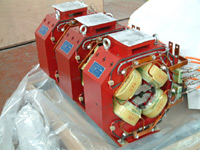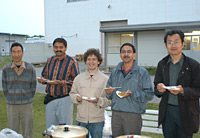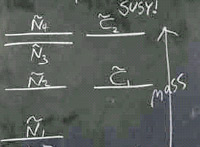 |
|
|
 |
China's Active ILC Participation with ATF2 Quadrupole Magnet Fabrication

IHEP will contribute 24 quadrupole magnets to ATF2 at KEK. |
The ATF2 experimental facility at KEK is one of the most important international collaboration programs dedicated to studying the ILC final focus subsystem. In ATF2, the beam will be extracted from a damping ring, ATF, and then focused transversely to less than 40 nanometers -- the smallest transverse beam size ever obtained. (The ILC required vertical beam size at the interaction point will be approximately 10 times smaller.)
To contribute actively to this important ILC R&D related program, the Institute of High Energy Physics (IHEP) of Chinese Academy of Sciences fabricated the required 24 quadrupole magnets for the first phase of ATF2 and will produce other magnets for the second phase. The first set of magnets was shipped to KEK in March, and the rest of the magnets will be available in this summer. During the production of the magnets, experts from IHEP, KEK, and SLAC collaborated efficiently to solve problems in fabrication and measurement.
Read more...
-- Jie Gao, IHEP |
 |
|
|
 |
Upcoming meetings, conferences, workshops
International Accelerator School for Linear Colliders
Sokendai, Graduate School for Advanced Studies
Hayama, Japan
19-27 May 2006
InterAction Meeting on ILC
KEK
29-30 May 2006
ILC Communicators Meeting
KEK
31 May 2006
ILC VTX Workshop at Ringberg
Ringberg Castle, Lake Tegernsee, Germany
28-31 May 2006
Second ATF2 Project Meeting
Japan
30 May-1 June 2006
Second Polarized RF Gun Meeting
SLAC
5 June 2006
CALOR 2006
12th International Conference on Calorimetry in High Energy Physics
Chicago, USA
5-9 June 2006
EPAC '06
Edinburgh, UK
26-30 June 2006
Vancouver Linear Collider Workshop
Vancouver, Canada
19-22 July 2006
ILC GDE Meeting
Vancouver, Canada
19-22 July 2006
Single Crystal Niobium Technology Workshop (pdf)
Araxá mine in Brazil
30 October-1 November 2006
Request Information (email)
TTC Meeting (Tesla Technology Collaboration)
KEK
25-28 Sep 2006
ILC GDE Meeting
Valencia, Spain
6-10 November 2006
GDE Meetings Calendar
|
|
 |
China, Japan and U.S. Collaborate on Magnet Design and Production for ATF2

IHEP just completed the second batch of magnets, designed by KEK and SLAC for ATF2. They will be shipped to KEK next week. |
The approximate number of magnets that the International Linear Collider will require: 17639.
The number of magnet styles that are needed in the ILC: 162.
Designing and building the perfect magnet system that produces high quality physics results: Priceless.
Scientists and magnet engineers in China, Japan and the United States recently collaborated together to design and build quadrupole magnets for the ATF2 project, which is currently under construction at KEK. A milestone for international collaboration on the International Linear Collider, KEK and SLAC designed the quadrupole magnets together and then worked closely with IHEP in Beijing, who managed the fabrication process in their shops.
Read more...
-- Elizabeth Clements |
 |
|
|
 |
ATF Welcomes a New Generation

About thirty scientists from around the world attended the ATF welcome party. |
In Japan, springtime is the start of the new year for schools and offices, and spring without an entrance ceremony is unimaginable. A lot of freshmen begin their new career in new places at this time of year. KEK meets with new companies. In celebration, the Accelerator Test Facility team has a new-comer welcome party.
ATF was constructed in 1997 at KEK. The facility aims to study the technical challenges of ultra-narrow emmittance. A lot of accelerator physicists around the world do research using ATF and test the performance of their equipment in make-shift operations. A team of such international accelerator physicists held the welcome party in front of the second container of ATF on 9 May.
Read more...
-- Nobuko Kobayashi, KEK |
 |
|
|
 |
Register for the Vancouver Linear Collider Workshop
On behalf of the ALCPG and GDE, the Local Organising Committee of the Vancouver Linear Collider Workshop, invites you to the July 2006 joint meeting of the American Linear Collider Physics Group and the International Linear Collider Global Design Effort - organised by TRIUMF. The workshop will be held on the Campus of the University of British Columbia in Vancouver, Canada, from Wednesday July 19 to Saturday July 22, with satellite meetings on July 18th and July 23.
More information...
ILC Related Preprints
hep-ph/0605225
22 May 2006
Scalar Top Quark Studies with Various Visible Energies
hep-ph/0605232
22 May 2006
Lepton Flavour Effects and Resonant Leptogenesis
hep-ph/0605197
17 May 2006
Probing the CP nature of Higgs boson through e- e+ -> e- e+ phi |
|
 |
 |
|
|
 |
Einstein’s Telescope

Supersymmetry (SUSY) – a conjectured new symmetry in nature
that could be key to the unification of the forces |
One of the most intriguing features of the ILC is its potential to act as a telescope to "explore energies a trillion times that of the accelerator itself, in the ultrahighenergy realm where physicists believe that all of nature's forces become one." Einstein spent much of his career trying to develop such a description of nature in a unified field theory, and we still seek such an understanding today.
I encourage our readers to get a copy or download a copy of "Discovering the Quantum Universe: The Role of Particle Colliders," a newly released publication and a companion piece to "The Quantum Universe," which was a very successful overview of the key questions in particle physics and astrophysics. I admit to being one of the authors of this new document, which is a popular exposition of the science of high energy particle colliders.
It is the fantastic science potential that excites us and motivates us to develop the new generation of particle colliders (LHC and ILC). We probably cannot even imagine what will be the most important science we will learn by exploring this new energy regime with such powerful instruments. Even so, "Discovering the Quantum Universe" explores some of our leading ideas by describing three main themes, "Mysteries of the Terascale," "Light on Dark Matter," and "Einstein's Telescope."
As we strive to uncover the fascinating science within these themes, it is fitting to keep in mind a well-known quote from Einstein, "The most incomprehensible thing about the world is that it is comprehensible." Happy reading!
--Barry Barish
Director's Corner Archive |
 |
|
|
 |
From SLAC today
18 May 2006
SLAC to Help Build KEK's ATF2
As particle physics becomes more and more of an international endeavor, SLAC researchers and engineers are following suit. SLAC has joined the international effort to build the Accelerator Test Facility 2 (ATF2), located at KEK in Japan, by designing forty-one "high-availability" power systems.
Read more...
From Scientific American
23 May 2006
Hard Landscape
Cosmology was always going to be trouble for particle physics. Traditional quantum theory predicts that the vacuum of space should bubble over with short-lived "virtual" particles, whose combined energy, represented by the so-called cosmological constant, would have long ago blown galaxies far and wide like grease on water at the touch of detergent.
Read more...
From New York Times
18 May 2006
Renewing America's Commitment to Research in High-Energy Physics
In October 2003, I gave an evening talk at the Fermi National Accelerator Laboratory in Batavia, Illinois. The subject was nature on the familiar scale, the kind embodied in the restored prairie on the Fermilab campus — some 1,200 acres of compass plant and rattlesnake master and other species.
Read more...
|
|

